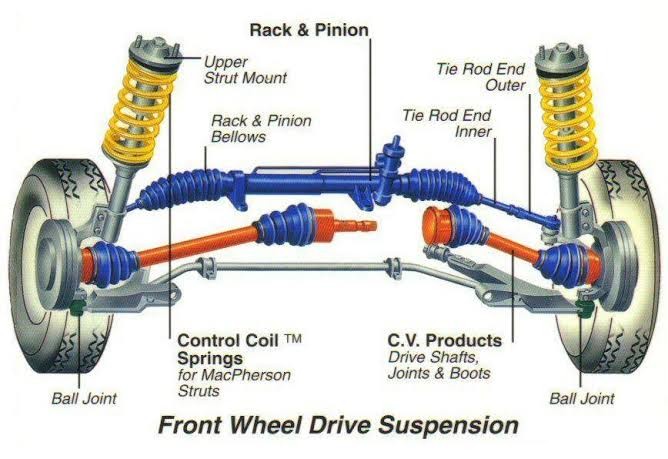Troubleshooting suspension issues can be challenging, but understanding the signs and knowing what to check can help.
Did you ever hear that? The telltale knocking under your vehicle as you hit a pothole might be your suspension crying for help. According to a recent study by the American Automobile Association, suspension-related issues account for nearly 15% of all vehicle maintenance costs, yet many drivers ignore these warning signs until they become expensive repairs.
As someone who's spent over two decades elbow-deep in suspension components, I've seen firsthand how early detection can save thousands in repair costs. Let's cut through the complexity and get straight to what you need to know.
Common Suspension Warning Signs That Demand Attention
Your vehicle's suspension system is constantly working to provide a smooth ride and maintain optimal handling. It's speaking to you constantly, you just need to know how to listen.
1. The Nose Dive
When you brake and your vehicle lurches forward dramatically, your struts or shocks are likely worn out. This isn't just uncomfortable; it's dangerous. Stopping distances increase significantly with worn suspension components, sometimes by up to 20 feet at highway speeds.
2. Uneven Tire Wear
Take a good look at your tires. Uneven wear patterns are like fingerprints for suspension problems. Cupping (scalloped dips around the tire's edge) almost always indicates bad shocks or struts. Wear on only one edge suggests an alignment issue, possibly from bent suspension components.
"The tire is often where suspension problems first reveal themselves, long before you hear or feel anything wrong," notes Mike Sowers, Technical Director at the Automotive Service Association. "A monthly tire inspection can catch issues early."
3. The Bounce Test
Here's a quick test I recommend to my clients: Push down hard on each corner of your vehicle and release. If it bounces more than twice before settling, your shock absorbers are likely failing. This simple test can identify problems before they worsen.
Diagnosing Specific Suspension Noises
Different noises point to different problems. Let's decode them:
| Noise | Likely Cause | Severity |
| Knocking when turning | Damaged strut mounts | High |
| Rattling at low speeds | Loose stabilizer links | Low to moderate |
| Squeaking during turns | Dry ball joints or tie rods | High |
| Clunking when going over bumps | Loose or worn control arm bushings | Moderate |
The Silent Killers: Ball Joint Failures
Ball joint failures deserve special attention. These critical components connect your control arms to the steering knuckles, and their failure can be catastrophic, potentially causing wheel separation at speed.
How to check: Jack up your vehicle safely with proper stands. Grab the tire at 12 and 6 o'clock positions and try to rock it. Any movement indicates worn ball joints. Also check at 3 and 9 o'clock for wheel bearing issues.
DIY Inspection vs. Professional Assessment
While DIY inspections can catch obvious issues, professional assessment includes critical measurements you can't perform at home. A suspension geometry check measures parameters like camber, caster, and toe alignments that affect both handling and tire wear.
"About 70% of the suspension problems I diagnose weren't even noticed by the vehicle owner," explains Jason Serrano, Master Technician at European Auto Specialists. "By the time you feel something wrong, you've typically been driving with the issue for months."
Cost-Effective Repair Strategies
Not all suspension repairs require complete replacement. Here are some strategic approaches:
- Prioritize safety components - Ball joints, tie rods, and control arms affect steering and should never be neglected.
- Consider complete sets - When replacing struts or shocks, do both sides of an axle simultaneously. This prevents handling imbalances and saves on labor costs for future repairs.
- Quality matters - I've seen countless "budget" parts fail prematurely. OEM or high-quality aftermarket components typically provide better value over time.
- Watch for collateral damage - Suspension problems rarely occur in isolation. When a strut fails, it often damages the spring, mount, and bearing plate as well.
Your suspension isn't just about comfort, it's about safety and vehicle longevity. Those clunks and rattles aren't just annoying; they're warning signs of potentially serious issues.
I recommend having your suspension professionally inspected annually or every 15,000 miles, whichever comes first. This preventative approach typically saves my clients an average of $800-1,200 in avoided repairs and extends vehicle life by years.
What's your vehicle trying to tell you? Pay attention to those early warning signs, and your suspension will thank you with thousands of miles of safe, comfortable driving.

Comments (0)
Please login to join the discussion
Be the first to comment on this article!
Share your thoughts and start the discussion